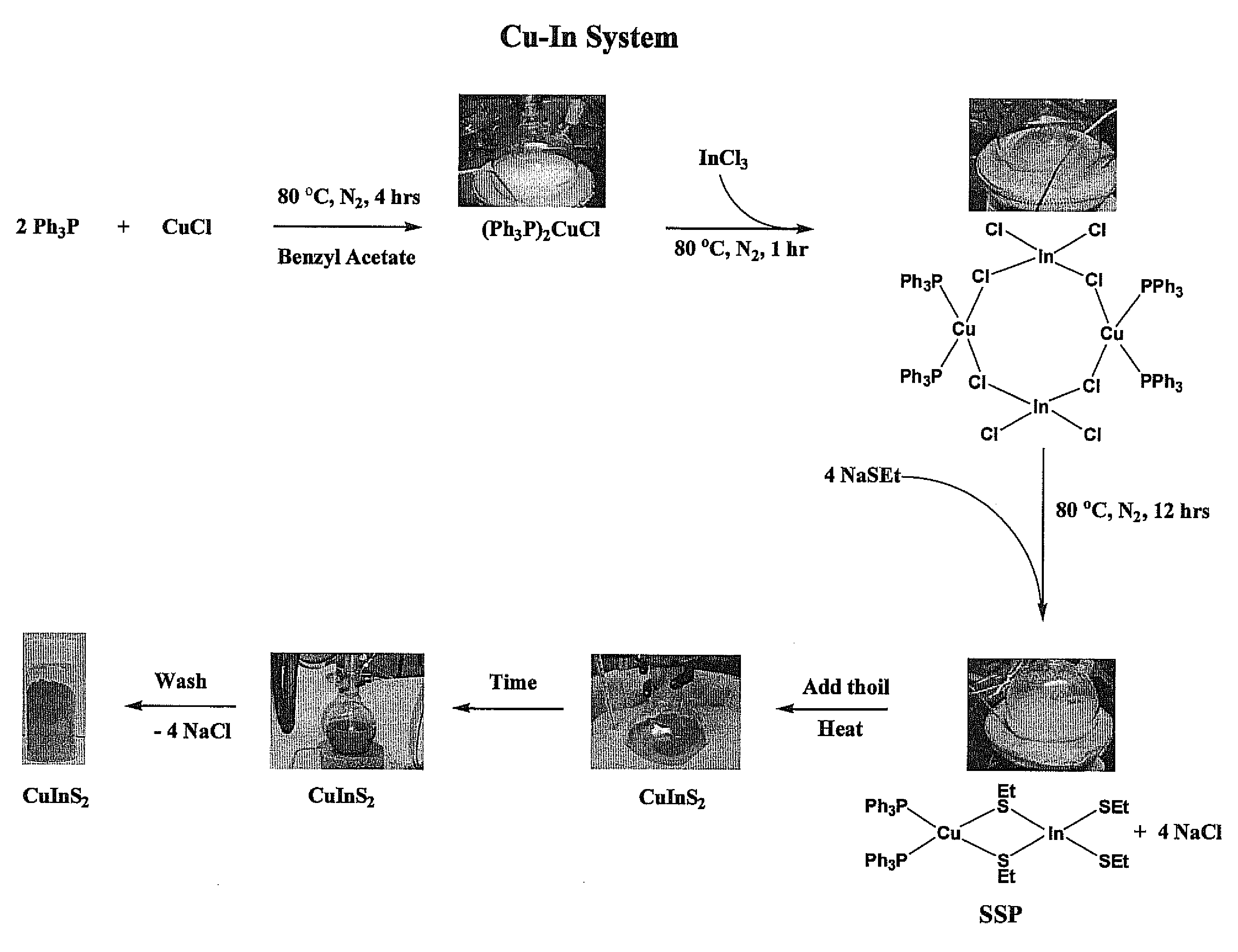One-pot synthesis of chalcopyrite-based semi-conductor nanoparticles
a semiconductor nanoparticle and chalcopyrite technology, applied in the field of one-pot synthesis of chalcopyrite-based semiconductor nanoparticles, can solve the problems of inherently limited silicon physical and chemical properties, inability to meet the requirements of silicon-based photovoltaic devices, and inability to meet the requirements of silicon-based devices in terms of basic raw materials, etc., and achieve the effect of reducing the cost of silicon-based photovoltaic devices and reducing the cost of silicon
- Summary
- Abstract
- Description
- Claims
- Application Information
AI Technical Summary
Benefits of technology
Problems solved by technology
Method used
Image
Examples
example 1
Synthesis of CuInS2 Particles
[0172]Two (2) molar equivalents of Ph3P (10.00 grams, 38.13 millimoles) may be added to fifty (50) milliliters (mL) of benzyl acetate (C6H5CH2CO2CH3, 99%) to form a solution, which may be stirred. The benzyl acetate may be obtained commercially from Alfa Aesar (Ward Hill, Mass.). One (1) molar equivalent of anhydrous Cu(I)Cl (1.885 grams, 19.06 millimoles) may be added to the stirring solution and heated for about four (4) hours at eighty (80) degree Celsius (° C.) to form a white suspension including the intermediate product (Ph3P)2Cu—Cl. One (1) molar equivalent of anhydrous InCl3 (4.22 grams, 19.06 millimoles) may be added, after which this solution may be stirred for about sixty (60) minutes at eighty (80) degree Celsius (° C.). Four (4) molar equivalents of NaSEt (7.000 grams, 83.21 millimoles) may be added to this solution and stirred for an additional twelve (12) hours at eighty (80)° C. Twenty five (25) milliliters (mL) of 3-mercaptopropionic aci...
example 2
Synthesis of CuInS2 Particles
[0178]Two (2) molar equivalents of Ph3P (10.00 grams, 38.13 millimoles) may be added to one hundred (100) milliliters (mL) of benzyl acetate (C6H5CH2CO2CH3, 99%) to form a solution, which may be stirred. The benzyl acetate may be obtained commercially from Alfa Aesar (Ward Hill, Mass.). One (1) molar equivalent of anhydrous Cu(I)Cl (1.885 grams, 19.06 millimoles) may be added to the stirring solution and heated for about four (4) hours at eighty (80) degree Celsius (° C.) to form a white suspension including the intermediate product (Ph3P)2Cu—Cl. One (1) molar equivalent of anhydrous InCl3 (4.22 grams, 19.06 millimoles) may be added, after which this solution may be stirred for about sixty (60) minutes at eighty (80) degree Celsius (° C.). Four (4) molar equivalents of NaSEt (7.000 grams, 83.21 millimoles) may be added to this solution and stirred for an additional twelve (12) hours at eighty (80)° C. Twenty five (25) milliliters (mL) of 3-mercaptopropio...
example 3
Synthesis of CuInS2 Particles
[0179]Two (2) molar equivalents of Ph3P (10.00 grams, 38.13 millimoles) may be added to one hundred (100) milliliters (mL) of benzyl acetate (C6H5CH2CO2CH3, 99%) to form a solution, which may be stirred. The benzyl acetate may be obtained commercially from Alfa Aesar (Ward Hill, Mass.). One (1) molar equivalent of anhydrous Cu(I)Cl (1.885 grams, 19.06 millimoles) may be added to the stirring solution and heated for about four (4) hours at eighty (80) degree Celsius (° C.) to form a white suspension including the intermediate product (Ph3P)2Cu—Cl. One (1) molar equivalent of anhydrous InCl3 (4.22 grams, 19.06 millimoles) may be added, after which this solution may be stirred for about sixty (60) minutes at eighty (80) degree Celsius (° C.). Four (4) molar equivalents of NaSEt (7.000 grams, 83.21 millimoles) may be added to this solution and stirred for an additional twelve (12) hours at eighty (80)° C. Twenty five (25) milliliters (mL) of 3-mercaptopropio...
PUM
| Property | Measurement | Unit |
|---|---|---|
| sizes | aaaaa | aaaaa |
| temperature | aaaaa | aaaaa |
| temperature | aaaaa | aaaaa |
Abstract
Description
Claims
Application Information
 Login to View More
Login to View More - R&D
- Intellectual Property
- Life Sciences
- Materials
- Tech Scout
- Unparalleled Data Quality
- Higher Quality Content
- 60% Fewer Hallucinations
Browse by: Latest US Patents, China's latest patents, Technical Efficacy Thesaurus, Application Domain, Technology Topic, Popular Technical Reports.
© 2025 PatSnap. All rights reserved.Legal|Privacy policy|Modern Slavery Act Transparency Statement|Sitemap|About US| Contact US: help@patsnap.com



